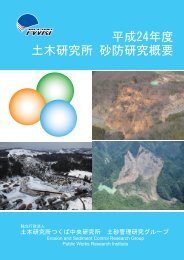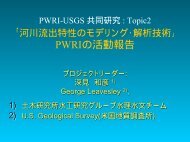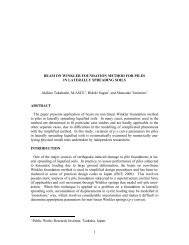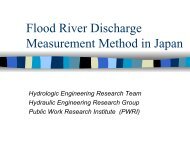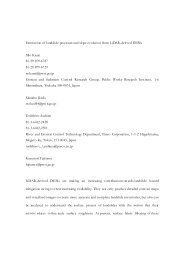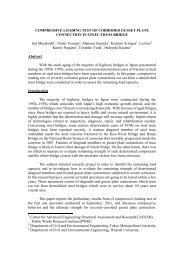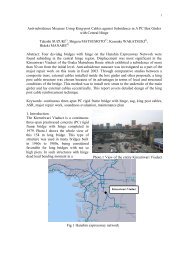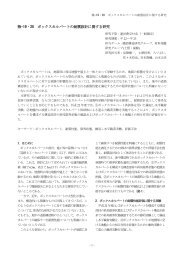INFILTRATION TRENCHES FOR HIGHWAY DRAINAGE ...
INFILTRATION TRENCHES FOR HIGHWAY DRAINAGE ...
INFILTRATION TRENCHES FOR HIGHWAY DRAINAGE ...
Create successful ePaper yourself
Turn your PDF publications into a flip-book with our unique Google optimized e-Paper software.
<strong>INFILTRATION</strong> <strong>TRENCHES</strong> <strong>FOR</strong> <strong>HIGHWAY</strong> <strong>DRAINAGE</strong><br />
Shinichiro NAKASHIMA, Shoichi TSUTSUMI and Takeshi OSHITA<br />
Construction Technology Research Team, Public Works Research Institute<br />
ABSTRACT<br />
Flood control facilities such as permeable pavements and infiltration trenches must be installed in<br />
Japan as stipulated by law when a new road over 1000 m 2 is developed in designated urban river<br />
basins. To find out the basic flood control performance of infiltration trenches, and to investigate<br />
the influence area of seepage water, infiltration tests for a real-size trench, and runoff calculations<br />
under normal trench condition were carried out. From the experimental results, it was confirmed<br />
that the capacity of infiltration trenches were evaluated accurately by the formula developed by the<br />
Association of Rainwater Storage and Infiltration Technology (1995), and that the saturation region<br />
from the trench was almost the same regardless of the soil type. From the runoff calculation results,<br />
the relationship between soil permeability and runoff control performance was confirmed.<br />
I. Introduction<br />
Devastation from floods in urban river basins is a big issue in Japan. Especially in recent years,<br />
urban-specific damage such as loss of lives by underground inundation, lifeline paralysis, and shut<br />
down of computer systems is increasing. One reason is that extremely urbanized river basins are<br />
losing their natural water-retaining and retarding functions. Second reason is that local torrential<br />
rains occur frequently these days due to abnormal climate conditions. On the other hand, it is<br />
difficult to construct conventional flood control measures such as river channel improvement and<br />
flood control dams due to the difficulty of securing land in urban areas.<br />
In order to prevent floods in urban areas, a law that regulates development in urban river basins<br />
was established in 2003. This law requires installation of storage and infiltration facilities when a<br />
new road over 1000 m 2 is developed in designated urban river basins.<br />
Permeable pavements and infiltration trenches are expected to be effective countermeasures to<br />
control runoff from roads (Figure 1). There are, however, few studies and examples of these<br />
facilities, because road construction engineers have believed that rainwater from roads should be<br />
drained to rivers as soon as possible from the viewpoint of driving safety and stability of earth<br />
structures. For application of the facilities to roads, therefore, there are many problems such as<br />
long-term runoff controlling performance of these facilities, the effect of rainwater seepage on the<br />
durability of pavements, the stability of earth structures, and the effect of road drainage seepage<br />
on the quality of groundwater.<br />
This study focuses on infiltration trenches as runoff control facilities for roads. In order to clarify the<br />
basic runoff control performance, laboratory tests and runoff calculations were carried out.<br />
Inlet<br />
Impermeable pavement<br />
Outflow<br />
Permeable pavement<br />
Outflow<br />
(a) Infiltration trench<br />
Infiltration trench<br />
Infiltration trench<br />
(b) Permeable pavement + Infiltration trench<br />
Figure1: Stormwater storage and infiltration facilities for road drainage<br />
II. Laboratory Test
A. Outline<br />
Capacity of infiltration trenches largely depends on the permeability of the ground and the<br />
groundwater level. In order to grasp the effect of these two factors, a real-size infiltration trench<br />
was constructed in a laboratory, and infiltration tests were carried out. Experimental infiltration<br />
capacity was compared with calculations from the formula developed by the Association of<br />
Rainwater Storage and Infiltration Technology (ARSIT, 1995), and applicability of the formula was<br />
verified. The influence area of seepage water was investigated using soil moisture meters set in<br />
the model ground.<br />
B. Test condition<br />
Figure 2 is the illustration of the model ground and the trench. The model ground was constructed<br />
in a concrete pit, which had drainage tanks on both sidewalls. The groundwater level was<br />
controlled using the drainage tanks. The remaining two walls were under an undrained condition.<br />
Therefore, this was a two-dimensional seepage model. The infiltration trench was 1.0 m wide, 1.25<br />
m deep, and 4.0 m long, with a perforated distribution pipe of φ400 mm inside. The trench was<br />
filled with gravel with a grain size of 20-30mm and was wrapped with filter fabric to prevent<br />
clogging. Measurements were inflow q in , water depth in the trench h, distribution of soil-moisture<br />
content by soil-moisture meters, and groundwater level distribution by observation wells.<br />
4000 3500 2000 1000 0 600 1500 2500 4000<br />
4000<br />
Soil-moisture meter<br />
Inflow pipe<br />
Observation well<br />
(a) Plan view<br />
Soil-moisture meters<br />
Obeservation well<br />
Flow meter<br />
Inflow pipe<br />
Valve<br />
from water tank<br />
350<br />
1250<br />
Filter fabric<br />
Water supply and<br />
drainage pipe<br />
4000<br />
1000<br />
Gravel<br />
(20 - 30 mm)<br />
Perforated distribution<br />
pipe 400 mm φ<br />
Initial groundwater level<br />
8000<br />
(b) Elevation view<br />
Figure 2: Configuration of the model test on infiltration trench (Unit: mm)<br />
Experimental parameters were permeability of soil and initial groundwater level. Three kinds of<br />
sand, Sand A, B, and C, were used as ground material in this experiment. Coefficients of
permeability of them are shown in Table 1. They were obtained from permeability tests in the<br />
laboratory. For initial groundwater level, deep level (G.L. -4.0m), and shallow level (G.L. -2.1 m)<br />
were tested. Test cases are shown in Table 2.<br />
Two kinds of inflow methods, constant head test and falling head test, were used. Their process is<br />
explained in Figure 3. In the constant head test, inflow q in is controlled holding the water depth of<br />
trench h constant. After reaching the targeted depth, the inflow q in is equal to the infiltration flow. As<br />
shown in Figure 3(a), the inflow q in decreases with time and converges to a constant value. The<br />
constant flow is called final infiltration flow q f . On the other hand, in the falling head test, inflow q in<br />
is stopped after the trench is full and the falling depth in the trench is measured, as shown in Figure<br />
3 (b). In this experiment, falling head tests were repeated three times for each case.<br />
Soil type<br />
Table 1: Material of model ground<br />
Degree of compaction<br />
D c [%]<br />
Coefficient of permeability<br />
k [cm/sec]<br />
Sand A Sand (Kasumigaura) 89 4.9×10 -3<br />
Sand B Silty sand (Edosaki) 82 2.2×10 -3<br />
Sand C Decomposed granite soil (Kasama) 81 2.9×10 -2<br />
Table 2: Test cases<br />
Case No. Ground material Initial groundwater level<br />
Case A0 Sand A Deep (GL -4.0 m)<br />
Case A1 Sand A Shallow (GL -2.1m)<br />
Case B0 Sand B Deep (GL -4.0 m)<br />
Case B1 Sand B Shallow (GL -2.1m)<br />
Case C0 Sand C Deep (GL -4.0 m)<br />
Case C1 Sand C Shallow (GL -2.1m)<br />
Inflow q in<br />
q in<br />
h<br />
Inflow q in<br />
q in<br />
h<br />
q f<br />
time<br />
time<br />
Depth in trench h<br />
Target depth<br />
Depth in trench h<br />
HWL<br />
(a) Constant head test<br />
time<br />
(b) Falling head test<br />
time<br />
Figure 3: The change of inflow and depth in trench of constant head and falling head test.<br />
C. Test results<br />
(1) Results of constant head infiltration test<br />
Figure 4 shows the change of inflow q in with time in the constant head tests. As shown in this figure,
infiltration flow decreases with time because of the growth of the saturation area in the ground. It<br />
is confirmed that the final infiltration flow q f , depends on the soil type and the initial groundwater<br />
level. Table 3 shows the final infiltration flow per one meter length of the trench q f [m 3 /hr/m] of all<br />
cases.<br />
300<br />
250<br />
200<br />
Case A0<br />
Case A1<br />
Case B0<br />
Case B1<br />
Q in<br />
[L/min]<br />
150<br />
100<br />
50<br />
0<br />
0 30 60 90 120 150 180<br />
t [min]<br />
Figure 4: Time - infiltration flow curve<br />
Soil<br />
Sand A<br />
Sand B<br />
Sand C<br />
Table 3: Experimental results of final infiltration capacities<br />
Head Final infiltration capacity<br />
Initial groundwater level h [m]<br />
q f [m 3 /hr/m]<br />
Deep (GL -4.0 m)<br />
1.25 m<br />
1.000<br />
0.75 m<br />
0.613<br />
0.25 m<br />
0.375<br />
Shallow (GL -2.1m)<br />
Deep (GL -4.0 m)<br />
Shallow (GL -2.1m)<br />
Deep (GL -4.0 m)<br />
Shallow (GL -2.1m)<br />
1.25 m<br />
0.75 m<br />
0.25 m<br />
1.25 m<br />
0.75 m<br />
0.25 m<br />
1.25 m<br />
0.75 m<br />
0.25 m<br />
1.25 m<br />
0.75 m<br />
0.25 m<br />
1.25 m<br />
0.75 m<br />
0.25 m<br />
0.763<br />
0.450<br />
0.220<br />
0.420<br />
0.296<br />
0.203<br />
0.291<br />
0.167<br />
0.068<br />
1.065<br />
0.615<br />
0.270<br />
0.885<br />
0.465<br />
0.150<br />
(2) Applicability of ARSIT formula<br />
According to the ARSIT manual (1995), the final infiltration flow of a trench can be calculated by<br />
the following formula.<br />
q f = k K (1)<br />
Where, q f : final infiltration flow per one meter of trench [m 3 /hr/m], k: coefficient of permeability of<br />
soil [m/hr], and K: specific infiltration flow [m 2 ]<br />
Specific infiltration flow K is a coefficient that depends on the shape and the size of the infiltration<br />
facility and the water head in the facility. In the case of the infiltration trench, the following formula<br />
is given on K in the manual.<br />
K = 3.093 h + 1.34 W + 0.677 (2)<br />
To evaluate the accuracy of the formula, K that is calculated from the equation (2) was compared<br />
with K’ that is calculated from the following equation, using final infiltration flow q f in Table 2 and the<br />
coefficient of permeability in Table 1.
K’ = q f /k (3)<br />
Figure 5 shows the comparison between K and K’. From this figure, it is confirmed that K is very<br />
close to K’ for Sand A and Sand B. This confirms that the formula of the ARSIT manual estimates<br />
the experimental infiltration capacity with good accuracy. In regard to Sand C, however, the ARSIT<br />
formula overestimated K in about six cases. It is inferred that the in-situ permeability of Sand C<br />
was much less than the value in Table 1 that was obtained by the laboratory permeability test.<br />
Aoyama et al. (1978) reported that the permeability of Sand C varies with the change of the<br />
hydraulic gradient and that it dropped to less than 1/10 in some tests. In this experiment, falling<br />
head tests were carried out before the constant head tests, and it was repeated three times. The<br />
falling head test might decrease the permeability of Sand C.<br />
7<br />
Specific infiltration K from experimental<br />
final infiltration flow<br />
K' = q f<br />
/ k [m 2 ]<br />
6<br />
5<br />
4<br />
3<br />
2<br />
1<br />
Sand A<br />
Sand B<br />
Sand C<br />
y = 0.1578 x<br />
0<br />
0 1 2 3 4 5 6 7<br />
Specific infiltration K from ARSIT formula<br />
K = ah + b [m 2 ]<br />
Figure 5: Comparison of K-value<br />
(3) Effect of groundwater level<br />
Figure 6 shows the comparison of q f between deep groundwater level cases and shallow<br />
groundwater level cases. From this figure, the plots are in the same straight line regardless of the<br />
soil type. This confirms that infiltration capacity can be formulated in consideration of the effect of<br />
initial groundwater level, although the equation (1) and (2) do not contain groundwater level terms.<br />
This is an issue to be studied in the future.<br />
1.2<br />
q f<br />
[m3/hr/m] of shallow groundwater level cases<br />
(Case A0, Case B0, Case C0)<br />
0.8<br />
0.4<br />
0.0<br />
Sand A<br />
Sand B<br />
Sand C<br />
y = 0.9019 x - 0.1023<br />
R 2 = 0.9954<br />
0.0 0.4 0.8 1.2<br />
q f<br />
[m3/hr/m] of deep groundwater level cases<br />
(Case A1, Case B1, Case C1)<br />
Figure 6: Comparison of infiltration flow q f between deep groundwater level cases and shallow<br />
groundwater level cases.<br />
(4) Influence area of seepage water<br />
Figure 7 shows the distribution maps of soil saturation after 5 hours holding the water depth of
1.25 m. The square plots show the locations of the soil-moisture meters, and the black plots show<br />
saturated sensors. From the maps, it is confirmed that the saturation region after many hours is<br />
almost the same regardless of the soil type.<br />
Installation of infiltration facilities is restricted around natural slopes and earth fills because the<br />
water seepage raises the risk of slope failure. The range of no-filtration-facilities zone is within a<br />
distance of 2H around slopes in Japan, as shown in Figure 8. H is a height of slope here. This is<br />
called the 2H-rule. The saturation area of Figure 7 is also superimposed on Figure 8. From Figure<br />
8 it is confirmed that if the trench is set 2H away from the slope, saturation regions do not reach the<br />
slope. This confirms that the 2H-rule is a reasonable rule from the viewpoint of slope stability.<br />
Seepage of natural slopes is, however, more complex, because their configuration is generally<br />
inhomogeneous and sometimes they have alternate layers and discontinuities, which is different<br />
from the model ground of this experiment.<br />
0 1 m 2 m 3 m 4 m<br />
1 m<br />
Locations of probes<br />
Saturated probes<br />
2 m<br />
3 m<br />
(a) Case A0<br />
0 1 m 2 m 3 m 4 m<br />
0 1 m 2 m 3 m 4 m<br />
1 m<br />
1 m<br />
2 m<br />
2 m<br />
3 m<br />
3 m<br />
(b) Case B0<br />
(c) Case C0<br />
Figure 7: Saturation region in the model ground observed by the soil moisture meters<br />
No-infiltration-facilities zone<br />
2H<br />
Infiltration trench<br />
Infiltration trench<br />
2H<br />
H > 2m<br />
3 m<br />
Saturated<br />
3 m<br />
< 3.5 m<br />
Saturated<br />
< 3.5 m<br />
Figure 8: Installation of infiltration facilities is restricted around slope for slope stability by law.<br />
Hatched area is saturated region obtained by the model tests.<br />
III. Runoff Calculation for Roads in Consideration of an Infiltration Trench<br />
A. Outline<br />
Flood control facilities are required by law to reduce the peak of runoff to the amount before the
development. The required performance is illustrated in Figure 9. In order to investigate basic<br />
performance of infiltration trenches, a runoff calculation was carried out under general road<br />
conditions. The Calculation condition and model is shown in Table 4 and Figure 10.<br />
Q 1<br />
B<br />
A: Before development<br />
B: After development<br />
C: After development (with runoff control facilities)<br />
Runoff flow Q<br />
Q 0<br />
A<br />
C<br />
Figure 9: Required performance of runoff control facilities. Peak flow should be reduced to the<br />
level before development.<br />
time<br />
Rainfall Condition<br />
Road Condition<br />
Trench Condition<br />
Table 4: Calculation condition<br />
Rainfall intensity data: Yokohama<br />
Return period: 10 years<br />
Rainfall pattern: Center-concentrated pattern<br />
Duration: 24 hours<br />
Concentration time: 10 min<br />
Road Width: B = 10 m<br />
Asphalt pavement<br />
Runoff coefficient f = 1.0<br />
Trench size: W 1.0 m, H 1.0 m<br />
Void percentage of trench: n = 0.5<br />
Permeability of soil: k = 10 -2 to 10 -5 cm/sec<br />
Infiltration capacity: Calculation from ARSIT formula<br />
q d<br />
q in<br />
n<br />
R<br />
B<br />
q in<br />
: Inflow of trench [m 3 /hr/m]<br />
q out<br />
: Infiltration of trench [m 3 /hr/m]<br />
q s<br />
: Storage of trench [m 3 /m]<br />
q d<br />
: Overflow of trench [m 3 /hr/m]<br />
h : Depth of trench [m]<br />
n : Void percentage of trench<br />
W : Width of trench [m]<br />
R : Rainfall intensity [m/hr]<br />
B : Catchment width [m]<br />
∆h<br />
h<br />
q s<br />
q out<br />
W<br />
Infiltration trench<br />
Figure 10: Runoff calculation model<br />
Continuity equation:<br />
q s<br />
= (q in<br />
- q out<br />
) ∆t<br />
Inflow of trench:<br />
q in<br />
= BR<br />
ARSIT fomula on infiltration of trench:<br />
q out<br />
= kK f<br />
K f<br />
= 3.093h+1.34W+0.677<br />
B. Results of runoff calculation<br />
Figure 11 shows calculation results for various ground permeabilities. The lines in the figure show<br />
overflow from the trench. From this figure, it is confirmed that the trench can control all of the<br />
rainfall when the ground permeability is 2.0x10 -3 cm/sec. In the case of k = 1.0x10 -3 cm/sec,
however, half of the rainwater overflows at peak. In the case of k is lower than 10 -4 cm/sec, peak<br />
flow is not cut off, because the infiltration capacity is too low.<br />
Figure 12 shows the calculation result of water depth in the trench with time, after the trench is full.<br />
From the figure, in the case of k = 10 -5 cm/sec, it takes more than two weeks for the trench to empty.<br />
This means that the trench cannot provide the required performance, if there is an antecedent<br />
precipitation. Therefore, in the case that the ground permeability is very low, like the example, a<br />
structural device is needed to prevent the inflow of normal rainfall, and to permit inflow only at peak<br />
periods.<br />
Rainfall intensity R [mm/hr]<br />
Overflow q d<br />
/B [mm/hr]<br />
120<br />
100<br />
80<br />
60<br />
40<br />
20<br />
0<br />
B = 10 m<br />
n = 0.5<br />
H = W = 1.0 m<br />
1.0x10 -4<br />
5.0x10 -4<br />
Coefficient of permeability Overflow ratio<br />
k [cm/sec] q d<br />
/B/R<br />
1.0x10 -3<br />
2.0x10 -3<br />
2.0x10 -3 (0.00)<br />
1.0x10 -3 (0.44)<br />
5.0x10 -4 (0.92)<br />
1.0x10 -4 (0.98)<br />
600 660 720 780 840 900<br />
Time t [min]<br />
Figure 11: Stormwater calculation results for various k.<br />
1.0<br />
k = 10 -5 cm/sec<br />
Depth of trench h [m]<br />
0.8<br />
0.6<br />
0.4<br />
0.2<br />
0.0<br />
k = 10 -3 cm/sec<br />
4 hr<br />
k = 10 -4 cm/sec<br />
1.7 day<br />
n = 0.5<br />
H = W = 1.0 m<br />
2.3 week<br />
1 10 100 1000<br />
Elapsed time after H.W.L. t [hr]<br />
Figure 12: Calculation result of the depth of trench after H.W.L.<br />
IV. Conclusion<br />
From laboratory tests and runoff calculations on infiltration trenches, the following were<br />
determined;<br />
1) The ARSIT formula estimated the experimental infiltration capacity of the trench accurately in<br />
the case of Sand A and B. The formula is applicable for the design of the infiltration trench.<br />
2) In the case of Sand C, however, the formula overestimated by six times the experimental<br />
infiltration capacity. This is because the permeability of Sand C decreased due to the change of<br />
the hydraulic gradient caused by the ups and downs of the water depth in the trench during the<br />
test.<br />
3) The result of Sand C implies a very important thing in the design of infiltration facilities. The<br />
permeability coefficient of the soil is one of the most important input datum, as can be seen in<br />
formula (1). In the case of particular kinds of soil like Sand C, however, if the facility is designed<br />
using a permeability coefficient from a constant head permeability test in a laboratory, the<br />
performance might be overestimated, because the permeability of the soil will decrease during<br />
in-service by the change of water depth in the facility. Therefore, in order to determine the lowest<br />
permeability of such soils, permeability tests in which the hydraulic gradient varies are needed.<br />
4) From the experimental result of the distribution of soil-moisture content, it was confirmed that
the saturation region of seepage water from the trench is almost constant regardless of the soil<br />
type.<br />
5) From the runoff calculation, the effect of soil permeability on the performance of an infiltration<br />
trench was confirmed. In the case k is higher than 10 -3 cm/sec, the infiltration function can be<br />
expected during a storm. In the case k is in the order of 10 -4 cm/sec, the infiltration function is<br />
hardly expected, and the storage function is only effective during a storm. The water stored<br />
during the rainfall should be infiltrated after a storm. In the case k is less than 10 -5 cm/sec,<br />
infiltration cannot be expected at all. Therefore, the trench should be designed not as an<br />
infiltration trench, but as a storage trench. In this case, a structural device is needed not to allow<br />
the inflow of normal rainfall.<br />
V. References<br />
Association of Rainwater Storage and Infiltration Technology, Manual for technology of rainwater<br />
infiltration facilities -planning & investigation-, 1995. (in Japanese)<br />
Aoyama et al., Permeability property of undisturbed Masa-sand, Proceedings of the 13th Japan<br />
National Conference on Geotechnical Engineering, pp.157-160, 1978. (in Japanese)<br />
VI. Biography of presenting authors<br />
Shinichiro NAKASHIMA, Dr. Eng, Researcher, Construction Technology Research Team, Public<br />
Works Research Institute<br />
Shoichi TSUTSUMI, Researcher, Construction Technology Research Team, Public Works<br />
Research Institute<br />
Takeshi OSHITA, Research Coordinator, Construction Technology Research Team, Public Works<br />
Research Institute



